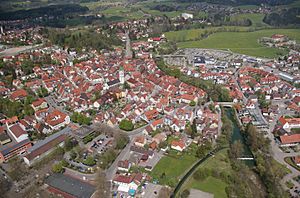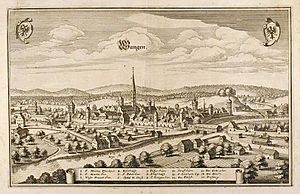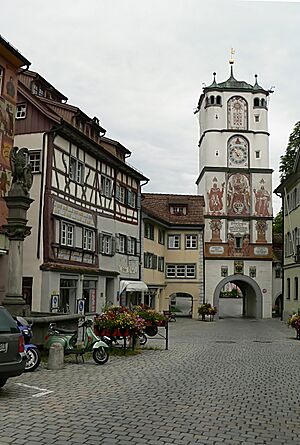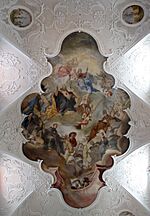Wangen im Allgäu facts for kids
Quick facts for kids
Wangen im Allgäu
|
||
|---|---|---|

Center of Wangen
|
||
|
||
| Country | Germany | |
| State | Baden-Württemberg | |
| District | Ravensburg | |
| Elevation | 556 m (1,824 ft) | |
| Population
(2022-12-31)
|
||
| • Total | 27,411 | |
| Time zone | CET/CEST (UTC+1/+2) | |
| Postal codes |
88239
|
|
| Dialling codes | 07522 | |
| Vehicle registration | RV | |
| Website | www.wangen.de | |
Wangen im Allgäu is a historic city in the southeast of Baden-Württemberg, Germany. It is located northeast of Lake Constance in the Westallgäu region. Wangen is the second-largest city in the Ravensburg district. It acts as an important center for the towns and villages around it. From 1938 to 1972, Wangen was the main town of its own rural district.
Contents
About Wangen's Location
Wangen im Allgäu is situated on the north bank of the Obere Argen river. The Untere Argen river flows past the northwest side of Wangen. It joins the Obere Argen southwest of the city. Today, the city is known for its old town center. It also has many nearby districts that are part of the city.
Neighboring Towns and Villages
Wangen is surrounded by several other communities. These include Amtzell, Vogt, Kißlegg, Argenbühl, and Achberg in the Ravensburg district. Also nearby are Hergatz and Hergensweiler in the Lindau district. Finally, Neukirch in the Bodensee district is also a neighbor.
Wangen's History
The city of Wangen was first mentioned in a monastery document in the year 815. Back then, its name was "Wangun."
In 1217, Emperor Fredrick II said that Wangen should stay under royal control. Later, in 1286, King Rudolph I gave Wangen a special status. It became a free imperial city. This meant it was directly under the Holy Roman Emperor, not a local lord.
During the late Middle Ages, Wangen grew a lot. This was because it was in a central spot. It was at the crossroads of important trade routes. These routes connected cities like Ravensburg, Lindau, Leutkirch, and Isny. Trade through the Alps also helped Wangen grow.
Wangen was very good at making and selling things. They were especially known for scythes (a tool for cutting grass) and canvas fabric. Selling these goods brought a lot of money into the city. This extra money was used to buy land outside the city walls. This helped protect Wangen from money problems.
In 1802, Wangen lost its special status as a Free City. It became part of the Kingdom of Bavaria. Then, in 1810, it became part of the Kingdom of Württemberg.
The city was officially named "Wangen in Allgäu" in 1936.
From 1938 until 1972, Wangen was the capital of the Wangen rural district. In 1972, this district was closed and joined with the Ravensburg district. In 1973, Wangen became a "Großen Kreisstadt." This means "large district town." It got this title because its population reached 20,000 people.
In 1999, Wangen had its biggest flood in 50 years. The lower part of the city was completely underwater. The Obere Argen river flooded the city again in 2006.
During the 2006 FIFA World Cup, the national soccer team from Togo stayed in Wangen.
Main Sights and Landmarks
Even though there were big fires in 1539, 1793, and 1858, the old part of Wangen still stands. It shows a mix of building styles. These styles range from the Early Middle Ages to the late Baroque era.
The Oberstadtkirche St. Martin ("St Martin's Upper City Church") is one of Wangen's oldest buildings. This church was already there in the 9th century. It was updated many times over the years. It has parts built in both Romanesque and Gothic architecture styles.
The Ravensburg Gate is a very important landmark of the city. It was first mentioned in 1472. However, it probably got its current look in 1608. The building is decorated with beautiful art from the Renaissance period. Other old parts of the city include the Lindau Gate and the Pfaffenturm tower.
The local history museum is called Heimatmuseum in der Eselmühle. It opened in 1974. It is located in an old mill that the city bought in 1969. The museum shows the original parts of the mill. It also has collections from different times in the city's history.
How Wangen's Population Grew
|
|
¹ Census
Twin Towns and Sister Cities
Wangen im Allgäu has "twin city" relationships with other towns. This means they share cultural ties and friendly exchanges. Wangen is twinned with:
 La Garenne-Colombes, France
La Garenne-Colombes, France Prato, Italy
Prato, Italy
Economy and Transportation
Wangen used to be a big center for Germany's textile industry. This means they made a lot of fabric and clothes. However, the German textile industry later became smaller.
Getting Around Wangen
Wangen is located on the A96 Autobahn. This major highway connects Lindau and Memmingen. The city also has access to federal highways 18 and 32. Train lines connect Wangen to places like Aulendorf, Kißlegg, Hergatz, Lindau, and Ulm. There are also bus routes between Ravensburg and Isny. The city is part of the Bodensee–Oberschwaben public transportation system.
Education in Wangen
Wangen has many schools for different age groups. These include:
- A Gymnasium (high school focused on academics) called Rupert-Neß-Gymnasium.
- A Realschule (a type of secondary school) called Johann-Andreas-Rauch-Realschule.
- A Hauptschule (another type of secondary school) called Hauptschule Karsee.
- A Werkrealschule (a school combining Hauptschule and Realschule) called Anton-von-Gegenbaur-Schule.
- A special school for students with special needs, called Martinstorschule.
- Three schools that combine secondary and elementary levels: GHS Niederwangen, Praßberg-Schule, and Freie Waldorfschule Wangen.
- Six elementary schools: Berger-Höhe-Schule, Deuchelried, Grundschule im Ebnet, Leupolz, Neuravensburg, and Schomburg.
The Wangen area also has two vocational schools. These teach skills for jobs. They are the Friedrich-Schiedel-Schule and the Kaufmännischen Schule Wangen. There is also the Heinrich-Brügger-Schule, which is a medical school.
Media and Local Government
Wangen gets its news from the Schwäbische Zeitung newspaper. It also has a local TV station called Regio TV.
The city has a local tax office. It also has a district court. This court is part of the Ravensburg regional court system.
Other Interesting Facts
- From 1943 to 1945, Wangen was used as a filming location for the movie Quax in Fahrt. This was a propaganda movie.
- From April 14 to May 13, 2004, the city and its nearby areas were used for filming the Tatort television series.
- The Wangen Juze Tonne e. V is known as the oldest youth center in Germany that is run by young people themselves.
- The Jugendmusikschule in Wangen is the largest music school in Baden-Württemberg.
Famous People from Wangen
- Joannes Susenbrotus (1484/1485 – 1542/1543): A German humanist and Latin teacher who wrote textbooks.
- Franz Joseph Spiegler (1691–1757): A German Baroque painter famous for his frescoes (wall paintings).
- Roland Bader (born 1938): A conductor who was the main guest conductor of the Kraków Philharmonic Orchestra.
- Frank Natterer (born 1941): A mathematician who works on computed tomography (CT scans).
- Matthias Ostermann (1951-2009): A Canadian potter, artist, and author. He moved from Wangen in 1953.
Sports Stars from Wangen
- Ernst Jakob Henne (1904–2005): A motorcycle racer who held the world land speed record.
- Patricia Watson-Miller (born 1965): A motorcycle rally raid driver. She won the ladies' cup of the Dakar rally three times.
- Sigrid Wille (born 1969): A cross-country skier.
- Ivana Rudelic (born 1992): A footballer who has played over 200 games and 34 for the Croatia women's team.
- Janik Haberer (born 1994): A footballer who has played over 300 games.
- Melanie Leupolz (born 1994): A soccer player who has played over 200 games and 79 for the Germany women's team.
Images for kids
See also
 In Spanish: Wangen im Allgäu para niños
In Spanish: Wangen im Allgäu para niños








